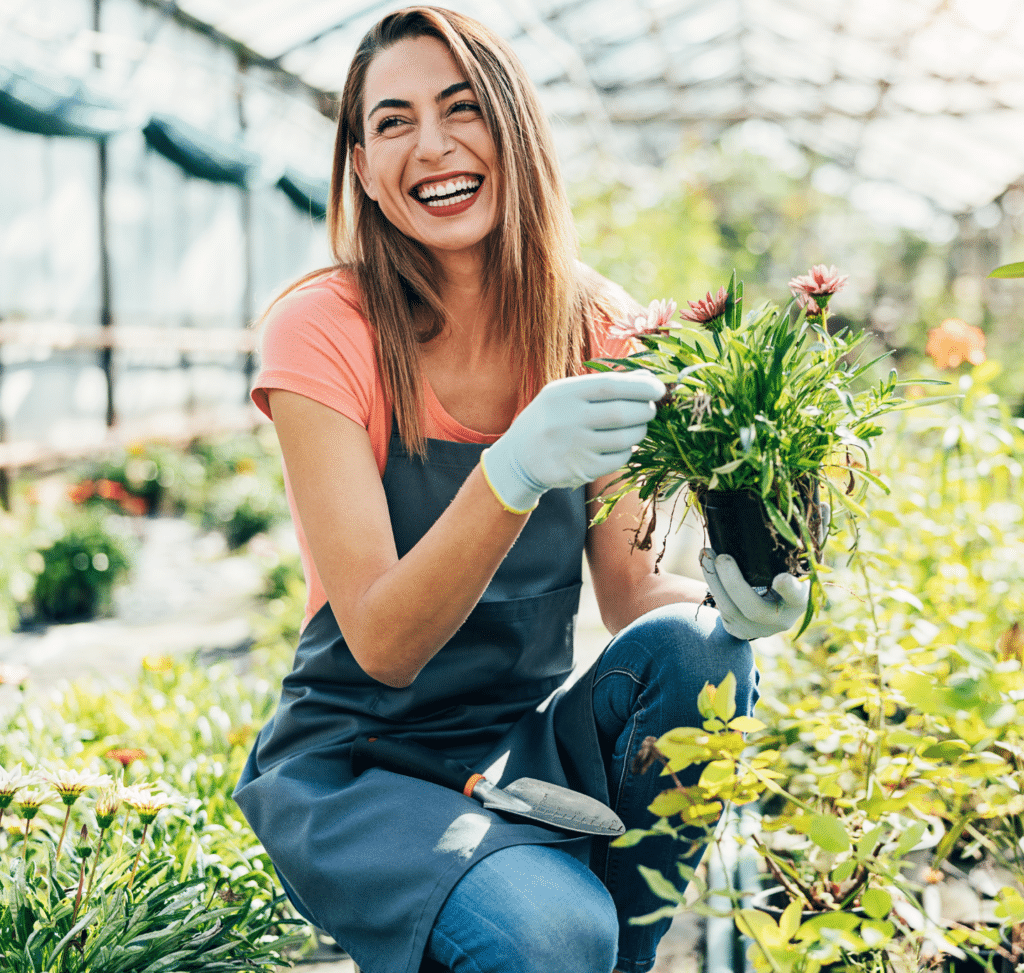What Is Horticultural Therapy? Benefits of Gardening for Mental Health

Horticultural therapy highlights the benefits of gardening for mental health. But what is horticultural therapy?
It can look different for everyone. For some, horticultural therapy means growing herbs in containers. Others might tend a small garden bed, but with guidance from someone trained to help connect each step to personal recovery goals.
Research points to real benefits of horticultural gardening for mental health. For instance, one study showed that people who spend at least two hours each week in natural settings often feel healthier and less stressed than those who don’t.¹ Because of findings like this, more hospitals, schools, and community organizations are including gardening in their services.
Gardening for emotional regulation brings a sense of routine, which is often needed after difficult times. It also creates grounding moments when everything else feels unpredictable. Simple activities – watering, noticing fresh leaves, watching the garden shift with each season – can, over time, help rebuild well-being and remind you that hope is still possible.
This guide explores:
- What horticultural therapy is and how it works
- How horticulture helps with trauma recovery
- Benefits of gardening for anxiety, depression, and trauma
- Therapeutic gardening techniques to try at home
- How Mission Connection can help

What Is Horticultural Therapy and How Does it Work?
Horticultural therapy uses gardening as a way to support mental and emotional health. It isn’t about having perfect blooms or rows of plants. It’s more about spending time with living things in a steady, hands-on way. This focus can feel calming when everything else seems too much.
During horticultural therapy sessions, people might look after a few potted plants or plan a small garden bed. They may also plant vegetables or simply sit outside. Regardless, a therapist is there to guide and offer ideas. These simple actions can help bring a feeling of ease and connection.
The therapy approach happens in spaces where you see change happen slowly. A sprout coming up, leaves starting to open – signs that care makes a difference over time.
Gardening therapy can be part of treatment in hospitals, schools, community programs, or private practices. Many find it helpful because it lowers stress and brings a sense of purpose without pressure to talk.
Research shows spending time like this can lift mood and reduce anxiety. For some, it also becomes a way to feel more hopeful again.²
How Gardening Improves Mental Health and Emotional Balance
Spending time with plants isn’t just a pleasant hobby – it has real effects on the brain and body. Gardening has been shown to lower levels of cortisol, the hormone linked to stress, and boost mood-enhancing chemicals like serotonin and dopamine. For example, one study found that 30 minutes of gardening reduced cortisol levels significantly more than 30 minutes of reading indoors.³
From a neuroscience perspective, gardening stimulates several parts of the brain linked to pleasure and calm. For example, touching soil can trigger the release of serotonin. This is partly because certain beneficial bacteria in soil, like Mycobacterium vaccae, help elevate mood when inhaled or absorbed through the skin.⁴
Additionally, the repetitive movements involved in planting and weeding activate the parasympathetic nervous system, which slows heart rate and helps the body recover from stress. In these ways, gardening promotes mental resilience.⁵
Gardening also lights up the brain’s reward centers, releasing dopamine when completing simple tasks like harvesting or seeing something bloom. This cycle of small, satisfying accomplishments can help create more emotional balance over time. In other words, gardening can improve mood and boost feelings of reward and satisfaction.⁶
To put it simply, gardening offers a gentle way to care for your mental health and reconnect with something steady and alive.
Benefits of Outdoor Gardening for Anxiety, Depression, and Trauma Recovery
Research shows that gardening does much more than provide a pleasant distraction – it can lead to measurable improvements in mental health.⁷ Thus, for people living with anxiety and depression, spending time in a garden may reduce symptoms in ways similar to more traditional therapy.
To break this effect down, studies on horticultural therapy found that it’s beneficial for both physical and mental health. For instance, a 15-session gardening intervention with low to moderate intensity improved muscle mass, endurance, cognitive ability, and waist circumference. In contrast, a 20-session program significantly reduced depression, anxiety, and cortisol levels.⁸
Gardening can also support trauma recovery by calming the body’s threat response.⁹ When you spend time outdoors and engage in repetitive, hands-on tasks, your nervous system gets the signal that you are safe and grounded. Over time, these gentle experiences can build trust in your ability to feel regulated and connected again.
Therapeutic gardening for mental wellness is sometimes called a “bottom-up” approach because it doesn’t rely only on talking about difficult memories. Instead, it offers a direct, sensory way to create new patterns in the brain and gently interrupt cycles of hypervigilance or emotional shutdown.
Some other benefits of gardening for mental health recovery include:
- A greater sense of accomplishment from nurturing plants and seeing progress
- Opportunities to practice patience and mindfulness in a low-pressure environment
- Gentle exposure to sensory experiences that feel calming and predictable
- Improved self-esteem from learning new skills and caring for living things
- A natural way to reconnect with a sense of purpose after trauma or loss
For many people, this kind of nature-based therapy for stress relief becomes a bridge back to feeling capable and hopeful, especially when traditional approaches have felt overwhelming or ineffective.
Gardening for Emotional Regulation: Horticultural Therapy Techniques and Activities You Can Try
One good thing about horticultural therapy is how flexible it is – you don’t need a big yard. Even a few pots on a balcony are enough to start exploring what gardening does for your mind. You can use the following techniques to get started.
Container Gardening
Many people try growing herbs or flowers in pots, which allows them to watch things grow, even if they don’t have an actual garden space. This is ideal for people who have limited space to work with.
Sensory Planting
Creating a sensory space can help someone focus on the present moment. Many people start a garden with plants that have different textures and smells. For instance, lavender, mint, and rosemary bring a calming scent. Also, running your hands over soft leaves or rough stems can help you notice what’s in front of you.
Raised Beds or Community Plots
If you have more space, you can plant in raised beds or join a shared garden. This gives you freedom to experiment and meet other people who enjoy gardening without having to focus intensely on the challenges you’re facing in everyday life.
Group Gardening
Some places run group sessions where you can work together on small projects. It’s a way to feel less alone and build connections without pressure to talk too much.
Mindful Gardening
Move slowly and notice small details like how the soil feels and what the air smells like. This simple focus can give your mind a break from worry.
Creative Projects
Give yourself a creative target. For example, set up a butterfly garden or place a few chairs among the plants. Simple ideas can turn a corner into a space that feels safe and your own.
There’s no single right way to begin horticultural therapy. Even ten minutes spent with your hands in soil can be a start.
Healing Through Nature: Why Working with Plants Supports Long-Term Recovery
Gardening has a way of reminding people of their capacity to shape and care for something outside themselves. Over time, this process can help rebuild a sense of agency – proof that your actions make a difference, even in small, steady ways.
Working with plants can also create a sense of curiosity. You may start to notice details that usually get overlooked, like how a sprout unfurls, how bees dip into blossoms, or how the soil smells just after rain. This type of gentle attention can pull your focus away from worry and reconnect you with the present moment.10
Many people find that therapeutic gardening becomes part of their identity in recovery. It offers a space to experiment, make mistakes without judgment, and discover what feels meaningful. Whether you’re exploring nature therapy for mental health recovery or simply looking for ways to feel more like yourself again, tending to plants can become a quiet but powerful practice.
In the long run, the mental health benefits of working with plants can include a deeper sense of belonging; to your environment, others, and your own unfolding story. It’s about discovering who you are when you’re no longer defined by stress or trauma.
Reach Out to Mission Connection for More Guidance on Healing Through Nature Therapy
If you’d like to explore how gardening could help you feel more settled, Mission Connection can share ideas and resources.
You don’t have to plan anything big. Some people keep a few pots by the window. Others join a group garden or take part in guided therapy sessions. Even small steps can feel worthwhile.
We can talk with you about different ways to use plants and nature in daily life. You might be curious about easing stress, lifting your mood, or finding a sense of purpose again. However, if you feel you need deeper support for your issues, we can also discuss our range of treatment options with us.
Feel free to contact us anytime. We’re here to answer any questions and help you look at options that feel right for you.

References
- White, M. P., Alcock, I., Grellier, J., Wheeler, B. W., Hartig, T., Warber, S. L., Bone, A., Depledge, M. H., & Fleming, L. E. (2019). Spending at least 120 minutes a week in nature is associated with good health and wellbeing. Scientific Reports, 9(1), 7730. https://pubmed.ncbi.nlm.nih.gov/31197192/
- Coventry, P. A., Brown, J. V. E., Pervin, J., Brabyn, S., Pateman, R., Breedvelt, J., Gilbody, S., Stancliffe, R., McEachan, R., & White, P. C. L. (2021). Nature-based outdoor activities for mental and physical health: Systematic review and meta-analysis. SSM – Population Health, 16, 100934. https://www.sciencedirect.com/science/article/pii/S2352827321002093#:~:text=A%20broader%20review%20that%20included,obesity%20and%20schizophrenia%20(Annerstedt%20et
- Van den Berg, A. E., & Custers, M. H. G. (2011). Gardening promotes neuroendocrine and affective restoration from stress. Journal of Health Psychology, 16(1), 3–11. https://pubmed.ncbi.nlm.nih.gov/20522508/#:~:text=Abstract,promote%20relief%20from%20acute%20stress
- Kim, S.-O., Kim, M. J., Choi, N.-Y., Kim, J. H., Oh, M. S., Lee, C. H., & Park, S.-A. (2022). Psychophysiological and metabolomics responses of adults during horticultural activities using soil inoculated with Streptomyces rimosus: A pilot study. International Journal of Environmental Research and Public Health, 19(19), Article 12901. https://pmc.ncbi.nlm.nih.gov/articles/PMC9564959/
- Sia, A., Tan, P. Y., Wong, J. C. M., Araib, S., Ang, W. F., & Er, K. B. H. (2022). The impact of gardening on mental resilience in times of stress: A case study during the COVID-19 pandemic in Singapore. Urban Forestry & Urban Greening, 68, 127448. https://pmc.ncbi.nlm.nih.gov/articles/PMC8695851/
- Soga, M., Gaston, K. J., & Yamaura, Y. (2017). Gardening is beneficial for health: A meta-analysis. Preventive Medicine Reports, 5, 92–99. https://www.sciencedirect.com/science/article/pii/S2211335516301401?via%3Dihub
- Thompson, R. (2018). Gardening for health: A regular dose of gardening. Clinical Medicine, 18(3), 201–205. https://www.sciencedirect.com/science/article/pii/S1470211824017056
- Han, A.-R., Park, S.-A., & Ahn, B.-E. (2018). Reduced stress and improved physical functional ability in elderly with mental health problems following a horticultural therapy program. Complementary Therapies in Medicine, 38, 19–23. https://www.sciencedirect.com/science/article/abs/pii/S0965229918301407#:~:text=A%2015%2Dsession%20gardening%20intervention,and%20anxiety%20in%20hospice%20patients
- Johnson, M., Waliczek, T. M., Etheredge, C., & Bradley, J. C. (2023). The connection between gardening and outdoor activity during the COVID-19 pandemic and perceptions of hope, hopelessness, and levels of stress, anxiety, and depression. HortTechnology, 33(2), 168–175. https://journals.ashs.org/view/journals/horttech/33/2/article-p168.xml
- Okvat, H. A. (2011). A pilot study of the benefits of traditional and mindful community gardening for urban older adults’ subjective well-being (Doctoral dissertation). Arizona State University. https://www.researchgate.net/publication/254256300_A_Pilot_Study_of_the_Benefits_of_Traditional_and_Mindful_Community_Gardening_For_Urban_Older_Adults’_Subjective_Well-Being





